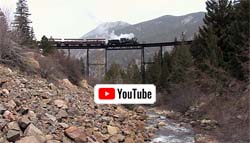this page

Georgetown Loop Railroad Wikipedia
Georgetown Breckenridge & Leadville Railway Wikipedia
Was the Georgetown Loop a poor design?The Denver & Rio Grande Western Narrow Gauge
Durango & Silverton Narrow Gauge Railroad
Cumbres & Toltec Scenic Railroad
Denver Public Library Photo Collection
The Narrow Gauge Circle (Link fails 11 May 2022)
Though the calendar says it's spring, it often still feels like winter high in the Front Range of the Rocky Mountains. In late April the Georgetown Loop Railroad opens for the year. There are frequently spring snowstorms at this time of year, and 2022 was no exception. This video takes a look at International Railways of Central America 2-8-0 Consolidation number 40 on the Georgetown Loop during the first few days of operation in April of 2022 - 1 May 2022.
P.R. Griswold, Richard H. Kindig, Cynthia Trombly.
1988
Rocky Mountain Railroad Club.
Hardcover.
254 pages, ? x ? inches, $75.86 (Used Amazon)
A pictorial history of the "Old Loop" and the incredible rebuilding of the "New Loop". 254 pages with text, photographs, maps and diagrams. Illustrated by Jan P. Rons.
Margaret and Claude Wiatrowski.
1992
Mountain Automation Corporation.
Paperback.
24 pages, ? x ? inches, $35.64 (Used Amazon)
The Georgetown Loop Railroad is a reconstruction of one of Colorado's most famous railroads. The track is narrow gauge as was the original, only three feet between the rails. The Loop is a serpentine arrangement of track that climbs three miles of track around 2 1/2 circles, even crossing over itself on Devil's Gate Bridge. The trains are owned by Georgetown Loop Railroad Inc. which operates this unique railroad for the Colorado Historical Society. A well done tourist guide illustrated throughout with color photos. With a 2 page map.
Dan Abbott.
1992
Publisher unknown.
Hardback.
192 Pages, 8.5 x 11 inches, US$70.00 (WRP Bookstore)
Georgetown Breckenridge & Leadville Railway was incorporated in 1880 to merge with the Colorado Central Railroad, build west to the mining camps in the Colorado mountains, connect with the Denver South Park & Pacific, and compete with the larger Denver & Rio Grande. Built in 1883, the Loop was an engineering marvel of the day, solving the problem of linking the towns of Silver Plume and Georgetown (only two miles apart), but with more than 600 feet in elevation difference. The Loop was more than 4.6 miles of track, including two hairpin turns and a viaduct where the route looped 100 feet over itself within the narrow mountain valley. This allowed the railroad grade to be traversed by conventional trains. In addition to serving the mines, the line proved a popular tourist destination. Indeed, the rebuilt Loop has hosted tens of thousands of riders each year since 1974. This new book details the history of the line until its abandonment in 1938.





